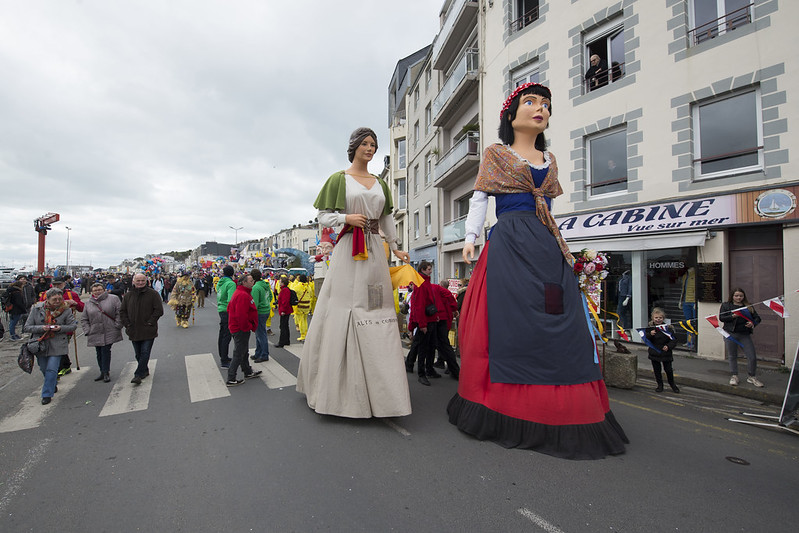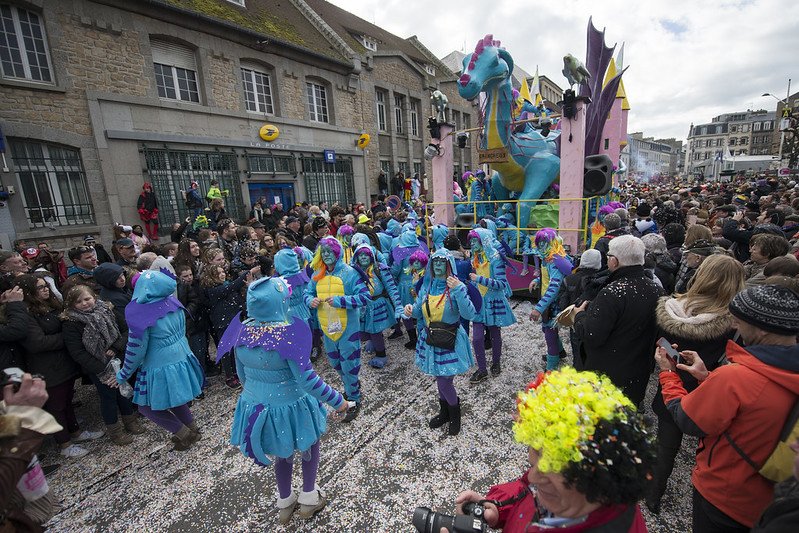Carnival of Granville
A Vibrant Seaside Celebration
2026/02/12 - 2026/02/16
Every February, the quiet coastal town of Granville in Normandy is engulfed in a whirlwind of color, satire, and jubilation. For five days leading up to Shrove Tuesday, over 150,000 visitors flood the streets to witness the largest carnival west of Paris. This UNESCO-recognized festival, deeply rooted in maritime history, offers a unique blend of tradition and satire that captivates both locals and tourists alike.
Main Attractions
The Grand Cavalcade
The heart of the carnival is undoubtedly the Grand Cavalcade, a spectacular parade featuring about 40 intricately designed floats. As the procession winds through Granville's narrow streets, the air fills with the rhythmic beats of brass bands and the excited chatter of the crowd. Each float, some towering up to 17 meters high, is a masterpiece of satire, often poking fun at current events, politicians, and celebrities. The sight of these colossal, colorful creations inching past centuries-old stone buildings creates a surreal juxtaposition of old and new.
The Confetti Battle
As twilight descends on Shrove Tuesday, the town square erupts in a frenzy of flying paper. The Great Confetti Battle is a sensory overload, with the air thick with swirling colors and the sound of laughter echoing off the buildings. Children and adults alike revel in the chaos, their hair and clothes quickly becoming a rainbow tapestry. The sweet, papery scent of confetti mingles with the salty sea air, creating an unforgettable olfactory memory of the carnival.
Culinary Delights
No French festival would be complete without a gastronomic experience. Street vendors line the carnival route, offering local specialties that warm both hands and stomach. The aroma of galettes saucisses (savory buckwheat crepes filled with sausage) wafts through the air, competing with the sweet scent of freshly made beignets dusted with powdered sugar. For a true taste of Normandy, visitors can sample the region's famous seafood, with oysters from nearby Cancale and succulent Chausey lobster available in many of the town's restaurants.
Cultural and Historical Background
The origins of Granville's Carnival date back to the 16th century when the town was a major cod fishing port. Fishermen would hold a final celebration before Lent, prior to embarking on their long and perilous voyage to Newfoundland. This tradition evolved, and on February 7, 1875, the first official carnival was held.
Today, this carnival demonstrates a strong connection to Granville's maritime history and culture. It provides a time for the community to come together, celebrate history, poke fun at authority, and temporarily escape the winter blues. Its inscription on UNESCO's Intangible Cultural Heritage list in 2016 is a testament to the festival's cultural significance and the town's commitment to preserving this unique tradition.
Participants Voices
It was a completely different experience from German carnivals. This seaside town carnival has a unique charm. When I spoke in my broken French, everyone responded with a smile. The balance between the discipline of the parade and the free-spirited atmosphere was perfect, and the local cuisine was a constant surprise. I ate a dish called galette saucisse, which reminded me of German bratwurst. I was also intrigued by the economic impact this carnival has on the region. I think it's a wonderful example of how tourism and traditional culture can coexist. Next year, I'd like to come back and bring my friends.
I've been participating in this carnival since I was a child. It used to be much smaller, but the excitement remains the same. This year, I brought my grandchildren for the first time. Watching their eyes light up at the colorful sights and music as the giant floats passed by, I felt like I was back in my own childhood. The savory aroma of galettes and the laughter in the air - that's the essence of Granville. And the moment when the confetti rains down, it feels like being enveloped in joy itself.
Fun Facts
- Over 20 tons of confetti are used during the carnival parades - enough to fill an Olympic-sized swimming pool!
- Each float in the parade can take up to 700 hours to construct and decorate.
- The tradition of burning the Carnival King effigy at the end of the festival dates back to ancient rituals of renewal and purification.
- Granville is often nicknamed the 'Monaco of the North' due to its clifftop location and once-glamorous reputation.
- The Chausey Islands, just off the coast of Granville, form the largest archipelago in Europe with 365 islets at low tide.
Festival Dates
The Granville Carnival typically takes place in late February or early March, lasting for five days leading up to Shrove Tuesday.
The event schedule is subject to change. Please check the official website for the most up-to-date information.
Information
| Name | Carnival of Granville |
| Country | France |
| Area | Granville |
| Date | 2026/02/12 - 2026/02/16 |
| Link |
Upcoming Festivals
Whirling Dervishes Festival Turkey
A Mesmerizing Dance of Divine Love
2025/12/06Mevlana Celaleddin Rumi Commemoration Ceremony ( Şeb-i Arus ) Turkey
A Whirling Journey to Divine Love
2025/12/10Dia de la Virgen de Guadalupe Mexico
A Festival Weaving Faith, Fervor, and Mexican Identity
2025/12/11L'Escalade Switzerland
Geneva’s Grand Winter Festival of Courage, Chocolate, and Community
2025/12/12Umkhosi Wokweshwama South Africa
The Zulu First Fruits Festival—A Sacred Celebration of Land, Ancestors, and Renewal
2025/12/12Lucia Festival (St. Lucia's Day) Sweden
A Festival of Light Illuminating the Nordic Darkness
2025/12/15Las Posadas Mexico
The Luminous Quest for Sacred Shelter
2025/12/22Noche de Rabanos (Night of the Radishes) Mexico
A celebration blending art, farming heritage, and cultural traditions
2025/12/23Chant of the Sybil on Majorca Spain
A Medieval Prophecy Echoes Through Majorcan Christmas
2025/12/23‘Hatajo de Negritos’ and the ‘Hatajo de Pallitas’ Peru
A Christmas Festival of Rhythm, Faith, and Afro-Andean Heritage in Peru’s Ica Region

